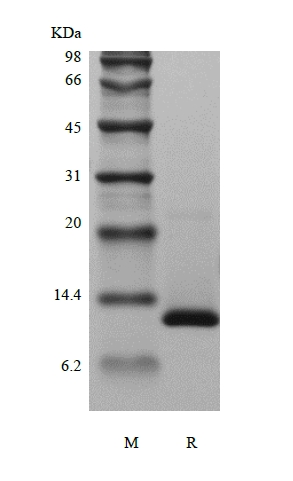| Official Full Name |
Recombinant Human Transforming Growth Factor – beta 2 (rHuTGF-beta2) |
| Squence |
 |
| Amino Acid Sequence |
|
| Synonyms |
|
| Accession Number |
|
| GeneID |
|
| Summary |
|
| Source |
Mouse myeloma cell line, NS0 |
| Molecular Weight |
|
| Biological Activity |
Measured by its ability to inhibit the IL-4-dependent proliferation of HT‑2 mouse T cells. The ED50 for this effect is 0.025-0.25 ng/mL. |
| Appearance |
Sterile Filtered White lyophilized (freeze-dried) powder. |
| Formulation |
Lyophilized from 0.2 um filtered concentrated solution in 35 % Acetonitrile and 0.1 % TFA. |
| Endotoxin |
Less than 0.1 EU/ug of rHuTGF-beta2 as determined by LAL method. |
| Reconstitution |
We recommend that this vial be briefly centrifuged prior to opening to bring the contents to the bottom. Reconstitute in sterile 4 mM HCl to a concentration of 0.1 mg/ml. Stock solutions should be apportioned into working aliquots and stored at ≤ -20 °C. Further dilutions should be made in appropriately buffered solutions. |
| Stability and Storage |
Use a manual defrost freezer and avoid repeated freeze-thaw cycles.- 12 months from date of receipt, -20 to -70 °C as supplied.- 1 month, 2 to 8 °C under sterile conditions after reconstitution.- 3 months, -20 to -70 °C under sterile conditions after reconstitution. |
| References |
TGF-beta2 is a pleiotropic cytokine that regulates immune function, cellular proliferation, and epithelial-mesenchymal transition. It shows cross-species activity in the development of cardiac, lung, craniofacial, limb, eye, ear, and urogenital systems. Latent TGF-beta is activated by proteolytic cleavage of the mature cytokine from the latency-associated peptide. TGF-beta2 signaling involves the accessory receptor Betaglycan, TGF-beta RII, and a type I TGF-beta receptor, resulting in the activation of Smad signal transduction. |
| SDS-PAGE |
 |
| Safety Data Sheet (SDS) Download |
Click to download |
| Technical Data Sheet (TDS) Download |
Click to download |



